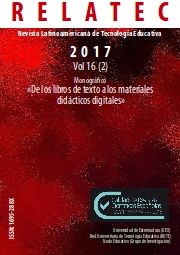Young high school students and technologies: an experience of collaborative production of digital didactic materials
DOI:
https://doi.org/10.17398/1695-288X.16.2.111Keywords:
Digital didactic material, Educational Technology, Youth, Research, DidacticAbstract
The paper presents results of research and teaching project focused on the production of digital didactic materials, developed with high school students of a Brazilian public school. The project included investigative activities carried out by the students themselves, guided by teachers from two different school disciplines, in order to solve real problems. The motivation was the organization of a collection of documents linked to an industry for the processing of the erva mate, as a didactic material to be used in school by other people to study the industrialization processes in the state of Paraná, at the beginning of the 20th century. The article addresses issues on information and communication technologies and their use in school; problematizes their insertion into school practices only to support traditional ways to teaching and learning based on teachers oral presentation; and proposes the organization of didactic activities with an emphasis on research and with an interdisciplinary character. In this proposition, students not only use digital didactic materials prepared by teachers or other agents, but contribute to produce didactic materials that will be used by other subjects. The analysis of the results was organized into three categories: 1. New forms of relationship with knowledge based on research; 2. technologies and differentiated modes of learning; 3. Training for professional world.
Downloads
References
Barca, I. (2004). Aula Oficina: do Projeto à Avaliação. In Para uma educação de qualidade. Atas da Quarta Jornada de Educação Histórica (pp131-144). Braga, PO: Centro de Investigação em Educação (CIED)/ Instituto de Educação e Psicologia (IED), Universidade do Minho.
Brasil (2015). Ministério da Educação. PNLD 2017 guia de livros didáticos – ensino fundamental anos finais / Ministério da Educação – Secretaria de Educação Básica SEB/ – Fundo Nacional de Desenvolvimento da Educação. Brasília, DF. Recuperado a partir de http://www.fnde.gov.br/programas/programas-do-livro/livro-didatico/guia-do-livro-didatico/item/8813-guia-pnld-2017
Fonseca, F. B.; Marcante, L. y Garcia, T. B. (2016). Elementos visuais e de conteúdo de livros didáticos de Filosofia: o ponto de vista dos jovens alunos. In Miguel Gómez; Tania García; Jesús Rodríguez. (Org.). Balance y análisis de la investigación sobre el libro de texto escolar y los medios digitales. (pp. 104-114). Pereira, Colômbia : Universidad Tecnológica de Pereira.
Chaves, E. (2015). A presença do livro didático de História em aulas do Ensino Médio: estudo etnográfico em uma escola do campo. (Doutorado. Não publicado). Curitiba: Universidade Federal do Paraná. Curitiba
Gama, R. (1986). A tecnologia e o trabalho na História. São Paulo: Nobel-Editora da Universidade de São Paulo.
Garcia, T. B.; Schmidt, M. A. (2011). Recriando Histórias a partir do olhar das crianças. Ijuí, RS : Unijuí.
Lima Filho, D. L., y Queluz, G. L. (2005). A tecnologia e a educação tecnológica: elementos para uma sistematização conceitual. Educação y Tecnologia, 10(1). Recuperado a partir de https://periodicos.cefetmg.br/index.php/revista-et/article/view/71
Mattozzi, I. (2008). Currículo de História e educação para o patrimônio. Educação em Revista, 47, 135-155. https://doi.org/10.1590/S0102-46982008000100009
Meneguci, L.; Santos, N. dos y Souza, T. (2016). LUNA: arquivo, tecnologia digital e experiência histórica (Documentação referente ao componente curricular Projeto e Desenvolvimento de Sistemas apresentado ao Curso Técnico Integrado em Informática do Instituto Federal do Paraná. Não Publicado). IFPR. Curitiba.
Meneguci, L.; Santos, N.; Souza, T. de; Garcia, C.; Chaves, E. (2016a). Projeto LUNA: arquivo, tecnologia digital e experiência histórica. Trabalho apresentado em congresso. Universidade Federal do Paraná. Curitiba.
Reis, R. (2014). Aprender na atualidade e tecnologias: implicações para os estudos no ensino médio. Educação e Realidade. 39(4), 1185-1207.
Schmidt, M. A. y Garcia, T.B. (2005). A formação da consciência história de alunos e professores e o cotidiano em aulas de história. Cadernos Cedes, 25 (67), 297-308.
Schmidt, M. A. y Garcia, T.B. (2003). O trabalho histórico na sala de aula. Londrina, 9, 219-238
Silva, A. C. F. da. (2013). Manuais de história para o ensino fundamental: a presença de fontes legais relacionadas à escravidão no Brasil. (Mestrado, não publicado. Universidade Federal do Paraná. Curitiba).
Vieira, E. A. y Garcia, T. B. (2016). Livros didáticos de Ensino Médio: o que pensam os alunos de uma escola de assentamento. In Miguel Gómez; Tania García; Jesús Rodríguez. (Org.). Balance y análisis de la investigación sobre el libro de texto escolar y los medios digitales. (pp. 205-215).Pereira, Colômbia : Universidad Tecnológica de Pereira.
Vincent, G.; Lahire, B. y Thin, D. (2001). Sobre a história e a teoria da forma escolar. Educação em Revista, 33, 7-47.
Williams, R. (2011). Cultura e Tecnologia. In Raymond Williams. Política do Modernismo. São Paulo: Editora Unesp.
Downloads
Published
Issue
Section
License
Authors who publish in this journal accept the following conditions:
1. The Author retains copyright in the article. Upon acceptance of the article, the author shall grant to the Publisher the right of first publication of the article. with the dcoument registered with the Creative Commons Attribution-NonCommercial-NoDerivative 4.0 International (CC BY-NC-ND) license, which allows to third parties to use what is published whenever they mention the authorship of the work and the first publication in this journal.
2. Authors can make other independent and additional contractual agreements for the non-exclusive distribution of the article published in this journal (eg, include it in an institutional repository or publish it in a book) provided they clearly indicate that the work was published for the first time in this journal.
3. Authors are allowed and recommended to publish their work on the Internet (for example on institutional or personal pages) before and during the review and publication process, as it can lead to productive exchanges and a greater and faster diffusion of published work (see The Effect of Open Access).









